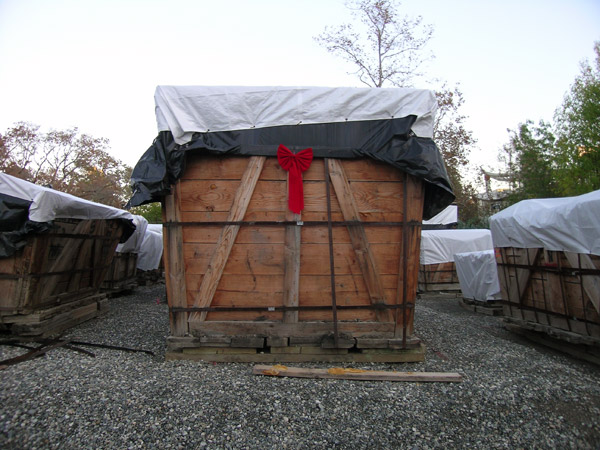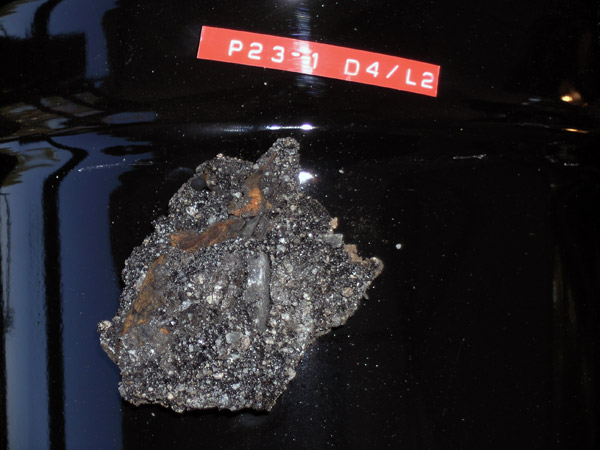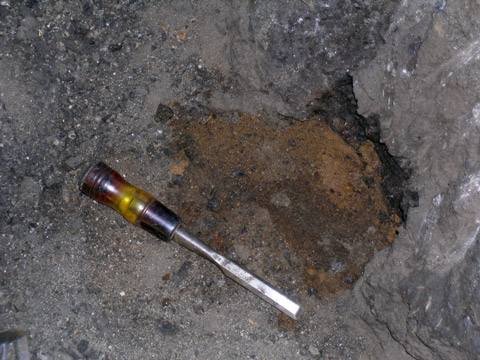
happy non-denominational seasons greetings and new year
It is 85 degrees Fahrenheit in Los Angeles right now. In January. In what is supposed to be the dead of winter. We are mildly confused, but not complaining; digging in asphalt is so much easier in the warm sun! The matrix in two particular grids -- A-1 and A-2 -- has been soft enough to dig through using our fingers. Findings of note:

This jaw is from a small wildcat, most likely a Lynx, per collections manager Christopher Shaw. We don't have that many bones from smaller cats in our collection at the Page Museum for two reasons: 1) these smaller cats were likely solitary, so when they got stuck in an asphalt seep, they got stuck alone -- not with 15 of their closest friends, as with Dire Wolves and Saber-toothed Cats. 2) smaller cats have small bones, and early fossil collectors (during the early 1900s) would have likely passed them over for larger, more obviously interesting fossils like, again, those of the Saber-toothed Cat. This is what's called a collection bias: the arbitrary favoring of one kind of fossil or specimen over another. One of the main goals of the excavation in Pit 91 and with Project 23 is to correct this bias. Thus, we collect and keep everything -- even the stuff that might not seem obviously important at the time. For instance:

In grid A-2/Level 3 I found two bird tibiotarsi (i.e. drumsticks) immediately on top of one another. They're definitely from the same species (but I don't know which one), one tibiotarsus was a left and the other was a right, and they are about the same size. This may be a case of association (two fossils from the same individual animal), or it may be just a really weird coincidence. But it kind of doesn't matter: it's an unusual enough case to warrant thorough documentation. Pictures, notes, and measurements have been taken, and preserved for posterity. I am but a lowly excavatrix -- not a proper paleontologist -- and I haven't the years of schooling necessary to interpret this assemblage. But good data collection will hopefully benefit actual paleontologists of the future, as they dive through field notes and make the interpretations that we excavators couldn't. Ryan, our sole man, noted the following:

The orange bits are a complete oak leaf found from a largely sterile portion of Deposit 1. We've found a large number of plant parts, and a good number of oak leaves in this deposit. We don't know what plant is worth collecting and what isn't, so we try to collect as much as possible. Again, this is something for future scientists to interpret. And it's our job to make sure everything's collected in as complete a manner as possible. Finally, an eagle-eyed volunteer (hi Spencer) spotted the following:

a pile of orange dirt. While this wouldn't be surprising in any other fossil deposit, anything with any hint of color at the La Brea Tar Pits is worth noting. So a sample was collected, notes were taken, and hopefully this will give us some insight into the depositional environment around this particular deposit.



2 comments:
Nice post. Enlightening! You'll be a paleontologist as soon as you present your paper; I, on the other hand, will have to wait until the clavicle study is published (who knows how long that will take). Remind me that I have an idea (stolen from Jack Tseng) for the blog that I need pics for.
tibiotarsi
Thank you. :-)
It's so exciting to see that little patch of sand on the blog...I was so enthralled with that, and it wasn't even a fossil.... Just below it I found a path of whitish sand, almost a cream or extremely pale yellow color. The whole thing was exactly like a pocket...just sitting there completely by itself. Amazing!
And may I also comment that it was not Ryan who discovered the leaf shown in the photo (although he greatly aided in the excavation and documentation), it was another "lone" male. *ahem*
Spencer
Post a Comment